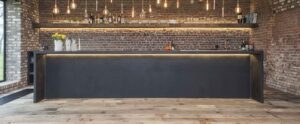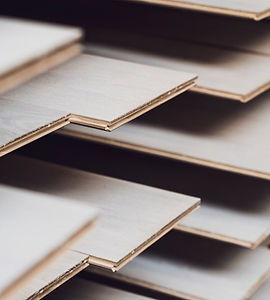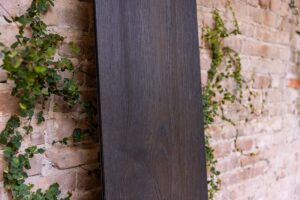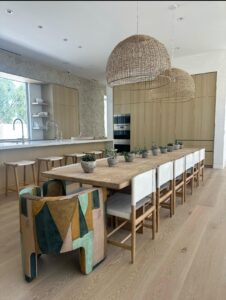The Difference Between Wood Veneer and Laminate Flooring, Part 1
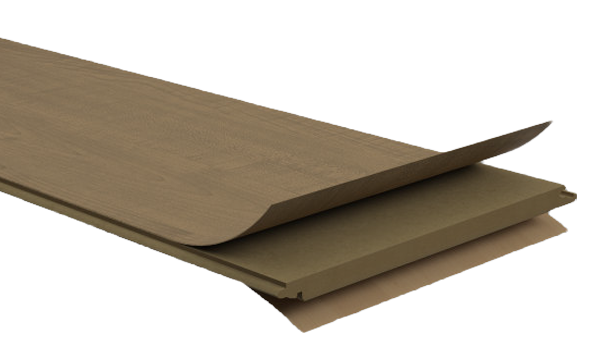
Part 1: Laminate Flooring
The Basic Difference: Laminate vs Hardwood Veneer Flooring
Generally, the difference between wood veneer and laminate flooring is that wood veneer flooring is made with real wood, while laminate is synthetic. Both engineered hardwood veneer and laminate flooring are durable. Wood veneer flooring is made with real wood on top of a high-density stable core board. Laminate flooring is made using a high-density particle board. On top is an image layer, a photographic layer that mimics or looks like wood, stone, or any other natural material.
The Structure of Laminate Flooring
Laminate flooring is a synthetic multilayered floor bonded to a high-density fiberboard core. It is designed to look like natural materials, like wood, tile, or stone.
The Layers Of Laminate Flooring
Protective Layer:
A layer that protects the surface. This rigid protective plastic sheet can be made up of aluminum oxide and melamine resin. This layer helps protect the laminate floor from scratches and stains.
Image Layer:
A photographic layer placed on a laminate floor core can look like wood, stone, tile, concrete, or any natural material. Since it is basically only a “photo,” it can look like almost any material.
Core:
Using “waste wood” and resin, a wood chip and plastic composite is pressed into layers using high heat, pressure, and bonding chemicals.
Bottom Layer:
It is usually a layer made of a dense material like melamine resin or paper, which can provide stability, moisture protection and structural support.
Advantages / Pros of Laminate Flooring
Cost Effective:
Laminate flooring is cheaper to make and, therefore, less expensive than real hardwood flooring. Since it is essentially only a photograph, it has a smooth surface free of seams.
Easy To Clean:
Sweeping and dry mopping will remove the dust and dirt from laminate floors. For deeper cleaning, a hard surface mopping tool that dispenses cleaning fluid is better than using water.
Scratch And Water Resistant:
Due to its protective coating, laminate flooring prevents scratching, denting, and water damage. They should last as long as the water or spills are removed within a short time and not left on the flooring unattended for longer periods.
Easier To Install:
Laminate flooring typically utilizes a simple click-lock system or can be placed on the subfloor. It can be installed right over old flooring (provided it’s still stable), eliminating the need for time-consuming and messy removal.
Disadvantages / Cons of Laminate Flooring
Not Moisture or Waterproof:
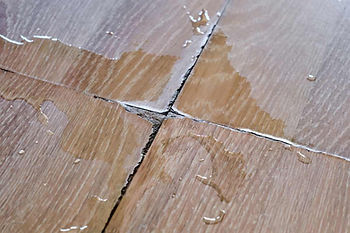
Laminate flooring should not be used in rooms with a high moisture content. Bathrooms, kitchens and laundry rooms, where water spills and moisture may be more likely to happen and soak into the floor, are rooms where the flooring can be more susceptible to damage. The moisture-sensitive particle board can warp, swell and stain beyond repair.
Prone To Chipping:
The laminate particle board can be prone to chipping. Small pieces of the top layer of a laminate floor can break off and create visible damage that can appear as small cracks and indentations. Chipping can be caused by impact, dropping heavy objects on the floor, dragging heavy furniture, excessive wear and tear and exposure to moisture or water. These can cause the laminate flooring surface to deteriorate.
Can’t Be Refinished:
Unlike engineered hardwood veneer flooring, the hard, thin, protective top layer of laminate flooring is not made to be refinished. This layer is a non-porous material that cannot be sanded or stained. Using a wet mop or wax may dull the finish. When your laminate flooring becomes worn or damaged, it must be replaced.
Environmental Impact:
Some laminate flooring may contain chemicals and adhesives that release volatile organic compounds (VOCs). These chemicals evaporate at room temperature and can cause irritation and indoor air quality issues. Laminate flooring is also non-biodegradable, meaning it cannot be easily recycled.
Ambiance:
Laminate flooring lacks the warmth and feel of genuine hardwood veneer flooring or a carpet. It is not as attractive as natural materials. It may also produce a hollow sound when walking on it.
Limited Lifespan:
Laminate flooring generally has a shorter limited lifespan. Over time, the core and the top protective layer of laminate flooring may become damaged or dull over time due to water, wear and tear. It can chip, peel, dent and scratch with heavy usage.
The Haute Plank Difference
Haute Plank is proud to offer a 25-year finish and lifetime structural warranty on our engineered hardwood veneer flooring products.
See how our complete engineered hardwood collection finished with the HP Titanium Finish and Maison Plank collections stands out as one of the toughest hardwood flooring finishes on the market and offers a highly durable, water-resistant flooring product.
View our Maison Plank collection or visit our Scottsdale showroom to see our impressive line of better-than-laminate wood-veneer hardwood floors firsthand. Not in the Valley? Contact us today for more information.




